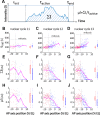3 minutes to precisely measure morphogen concentration
- PMID: 30365533
- PMCID: PMC6221364
- DOI: 10.1371/journal.pgen.1007676
3 minutes to precisely measure morphogen concentration
Abstract
Morphogen gradients provide concentration-dependent positional information along polarity axes. Although the dynamics of the establishment of these gradients is well described, precision and noise in the downstream activation processes remain elusive. A simple paradigm to address these questions is the Bicoid morphogen gradient that elicits a rapid step-like transcriptional response in young fruit fly embryos. Focusing on the expression of the major Bicoid target, hunchback (hb), at the onset of zygotic transcription, we used the MS2-MCP approach which combines fluorescent labeling of nascent mRNA with live imaging at high spatial and temporal resolution. Removing 36 putative Zelda binding sites unexpectedly present in the original MS2 reporter, we show that the 750 bp of the hb promoter are sufficient to recapitulate endogenous expression at the onset of zygotic transcription. After each mitosis, in the anterior, expression is turned on to rapidly reach a plateau with all nuclei expressing the reporter. Consistent with a Bicoid dose-dependent activation process, the time period required to reach the plateau increases with the distance to the anterior pole. Despite the challenge imposed by frequent mitoses and high nuclei-to-nuclei variability in transcription kinetics, it only takes 3 minutes at each interphase for the MS2 reporter loci to distinguish subtle differences in Bicoid concentration and establish a steadily positioned and steep (Hill coefficient ~ 7) expression boundary. Modeling based on the cooperativity between the 6 known Bicoid binding sites in the hb promoter region, assuming rate limiting concentrations of the Bicoid transcription factor at the boundary, is able to capture the observed dynamics of pattern establishment but not the steepness of the boundary. This suggests that a simple model based only on the cooperative binding of Bicoid is not sufficient to describe the spatiotemporal dynamics of early hb expression.
Conflict of interest statement
The authors have declared that no competing interests exist.
Figures








Similar articles
-
The time to measure positional information: maternal hunchback is required for the synchrony of the Bicoid transcriptional response at the onset of zygotic transcription.Development. 2010 Aug;137(16):2795-804. doi: 10.1242/dev.051300. Development. 2010. PMID: 20663819
-
Gene expression noise in spatial patterning: hunchback promoter structure affects noise amplitude and distribution in Drosophila segmentation.PLoS Comput Biol. 2011 Feb 3;7(2):e1001069. doi: 10.1371/journal.pcbi.1001069. PLoS Comput Biol. 2011. PMID: 21304932 Free PMC article.
-
Live imaging of bicoid-dependent transcription in Drosophila embryos.Curr Biol. 2013 Nov 4;23(21):2135-9. doi: 10.1016/j.cub.2013.08.053. Epub 2013 Oct 17. Curr Biol. 2013. PMID: 24139736
-
Constraints and limitations on the transcriptional response downstream of the Bicoid morphogen gradient.Curr Top Dev Biol. 2020;137:119-142. doi: 10.1016/bs.ctdb.2019.12.002. Epub 2020 Jan 17. Curr Top Dev Biol. 2020. PMID: 32143741 Review.
-
A matter of time: Formation and interpretation of the Bicoid morphogen gradient.Curr Top Dev Biol. 2020;137:79-117. doi: 10.1016/bs.ctdb.2019.11.016. Epub 2019 Dec 27. Curr Top Dev Biol. 2020. PMID: 32143754 Review.
Cited by
-
Transcription factor clusters as information transfer agents.ArXiv [Preprint]. 2024 Nov 6:arXiv:2403.02943v3. ArXiv. 2024. Update in: Sci Adv. 2025 Jan 3;11(1):eadp3251. doi: 10.1126/sciadv.adp3251. PMID: 38495568 Free PMC article. Updated. Preprint.
-
The Role of Biophysical Factors in Organ Development: Insights from Current Organoid Models.Bioengineering (Basel). 2024 Jun 18;11(6):619. doi: 10.3390/bioengineering11060619. Bioengineering (Basel). 2024. PMID: 38927855 Free PMC article. Review.
-
The linear framework: using graph theory to reveal the algebra and thermodynamics of biomolecular systems.Interface Focus. 2022 Jun 10;12(4):20220013. doi: 10.1098/rsfs.2022.0013. eCollection 2022 Aug 6. Interface Focus. 2022. PMID: 35860006 Free PMC article. Review.
-
The Drosophila Pioneer Factor Zelda Modulates the Nuclear Microenvironment of a Dorsal Target Enhancer to Potentiate Transcriptional Output.Curr Biol. 2019 Apr 22;29(8):1387-1393.e5. doi: 10.1016/j.cub.2019.03.019. Epub 2019 Apr 11. Curr Biol. 2019. PMID: 30982648 Free PMC article.
-
The dynamic transmission of positional information in stau- mutants during Drosophila embryogenesis.Elife. 2020 Jun 8;9:e54276. doi: 10.7554/eLife.54276. Elife. 2020. PMID: 32511091 Free PMC article.
References
-
- Driever W, Nusslein-Volhard C. A gradient of bicoid protein in Drosophila embryos. Cell. 1988;54(1):83–93. - PubMed
Publication types
MeSH terms
Substances
LinkOut - more resources
Full Text Sources
Molecular Biology Databases
Research Materials
Miscellaneous

